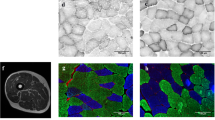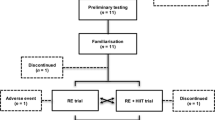Abstract
Muscle strength and mass decline in sedentary individuals with aging. The present study investigated the effects of both age and 21 weeks of progressive hypertrophic resistance training (RT) on skeletal muscle size and strength, and on myostatin and myogenin mRNA expression in 21 previously untrained young men (26.0 ± 4.3 years) and 18 older men (61.2 ± 4.1 years) and age-matched controls. Vastus lateralis muscle biopsies were taken before and after RT. Type I and type II muscle fiber cross-sectional areas increased more in young men than in older men after RT (P < 0.05). Concentric leg extension increased (P < 0.05) more after 10.5 weeks in young men compared to older men, but after 21 weeks no statistical differences existed. The daily energy and protein intake were greater (P < 0.001) in young subjects. Both myostatin and myogenin mRNA expression increased in older when compared with young men after RT (P < 0.05). In conclusion, after RT, muscle fiber size increased less in older compared to young men. This was associated with lower protein and energy intake and increases in myostatin gene expression in older when compared to young men.




Similar content being viewed by others
References
American College of Sports Medicine (2009) Position stand: progression models in resistance training for health adults. Med Sci Sports Exerc 41:687–708
Anthony JC, Anthony TG, Kimball SR, Vary TC, Jefferson LS (2000) Orally administered leucine stimulates protein synthesis in skeletal muscle of postabsorptive rats in association with increased eIF4F formation. J Nutr 130:139–145
Bamman MM, Hill VJ, Adams GR et al (2003) Gender differences in resistance-training-induced myofiber hypertrophy among older adults. J Gerontol A Biol Sci Med Sci 58:108–116
Bickel CS, Cross JM, Bamman MM (2011) Ecercise dosing to retain resistance training adaptations in young and older adults. Med Sci Sports Exerc 43:1177–1187
Campbell WW, Leidy HJ (2003) Dietary protein and resistance training effects on muscle and body composition in older persons. J Am Coll Nutr 26:696S–703S
Charge SB, Rudnicki MA (2004) Cellular and molecular regulation of muscle regeneration. Physiol Rev 84:209–238
Cuthbertson D, Smith K, Babraj J et al (2005) Anabolic signaling deficits underlie amino acid resistance of wasting, aging muscle. FASEB J 19:422–424
Dalbo VJ, Roberts MD, Sunderland KL et al (2011) Acute loading and aging effects on myostatin pathway biomarkers in human skeletal muscle after three sequential bouts of resistance exercise. J Gerontol A Biol Sci Med Sci 66:855–865
Dangin M, Guillet C, Garcia-Rodenas C et al (2003) The rate of protein digestion affects protein gain differently during aging in humans. J Physiol 549:635–644
Dreyer HC, Blanco CE, Sattler FR, Schroeder ET, Wiswell RA (2006) Satellite cell numbers in young and older men 24 hours after eccentric exercise. Muscle Nerve 33:242–253
Durnin JV, Womersley J (1974) Body fat assessed from total body density and its estimation from skinfold thickness: measurements on 481 men and women aged from 16 to 72 years. Br J Nutr 32:77–97
Evans W (1995) What is sarcopenia? J Gerontol 1995: 50A(special issue):5–8
Fiatarone MA, O’Neill EF, Ryan ND et al (1994) Exercise training and nutritional supplementation for physical frailty in very elderly people. N Engl J Med 330:1769–1775
Flück M, Däpp C, Schmutz S, Wit E, Hoppeler H (2005) Transcriptional profiling of tissue plasticity: role of shifts in gene expression and technical limitations. J Appl Physiol 99:397–413
Fujita S, Dreyer HC, Drummond MJ, Glynn EL, Cadenas JG, Yoshisawa F, Volpi E, Rasmussen BB (2007) Nutrient signaling in the regulation of human muscle protein synthesis. J Physiol 582:813–823
Guillet C, Prod’homme M, Balage M et al (2004) Impaired anabolic response of muscle protein synthesis is associated with S6K1 dysregulation in elderly humans. FASEB J 18:1586–1587
Häkkinen K, Häkkinen A (1991) Muscle cross-sectional area, force production and relaxation characteristics in women at different ages. Eur J Appl Physiol 62:410–414
Häkkinen K, Newton RU, Gordon SE et al (1998) Changes in muscle morphology, electromyographic activity, and force production characteristics during progressive strength training in young and older men. J Gerontol A Biol Sci Med Sci 53:B415–B423
Häkkinen K, Alen M, Kallinen M, Newton RU, Kraemer WJ (2000) Neuromuscular adaptation during prolonged strength training, detraining and re-strength-training in middle-aged and elderly people. Eur J Appl Physiol 83:51–62
Häkkinen K, Kraemer WJ, Newton RU, Alen M (2001a) Changes in electromyographic activity, muscle fibre and force production characteristics during heavy resistance/power strength training in middle-aged and older men and women. Acta Physiol Scand 171:51–62
Häkkinen K, Pakarinen A, Kraemer WJ, Häkkinen A, Valkeinen H, Alen M (2001b) Selective muscle hypertrophy, changes in EMG and force, and serum hormones during strength training in older women. J Appl Physiol 91:569–580
Harridge S, Kryger A, Steengaard A (1999) Knee extensor strength, activation, and size in very elderly people following strength training. Muscle and Nerve 22:831–839
Hulmi JJ, Ahtiainen JP, Kaasalainen T et al (2007) Postexercise myostatin and activin IIb mRNA levels: effects of strength training. Med Sci Sports Exerc 39:289–297
Hulmi JJ, Kovanen V, Lisko I, Selanne H, Mero AA (2008) The effects of whey protein on myostatin and cell cycle-related gene expression responses to a single heavy resistance exercise bout in trained older men. Eur J Appl Physiol 102:205–213
Hulmi JJ, Kovanen V, Selanne H, Kraemer WJ, Häkkinen K, Mero AA (2009a) Acute and long-term effects of resistance exercise with or without protein ingestion on muscle hypertrophy and gene expression. Amino Acids 37:297–308
Hulmi JJ, Tannerstedt J, Selanne H, Kainulainen H, Kovanen V, Mero AA (2009b) Resistance exercise with whey protein ingestion affects mTOR signaling pathway and myostatin in men. J Appl Physiol 106:1720–1729
Ivey FM, Roth SM, Ferrell RE et al (2000) Effects of age, gender, and myostatin genotype on the hypertrophic response to heavy resistance strength training. J Gerontol A Biol Sci Med Sci 55:M641–M648
Jespersen JG, Nedergaard A, Andersen LL, Schjerling P, Andersen JL (2011) Myostatin expression during human muscle hypertrophy and subsequent atrophy: increased myostatin with detraining. Scand J Med Sci Sports 21:215–223
Katsanos CS, Kobayashi H, Sheffield-Moore M, Aarsland A, Wolfe RR (2005) Aging is associated with diminished accretion of muscle proteins after the ingestion of a small bolus of essential amino acids. Am J Clin Nutr 82:1065–1073
Katsanos CS, Kobayashi H, Sheffield-Moore M, Aarsland A, Wolfe RR (2006) A high proportion of leucine is required for optimal stimulation of the rate of muscle protein synthesis by essential amino acids in the elderly. Am J Physiol Endocrinol Metab 291:E381–E387
Kim JS, Cross JM, Bamman MM (2005a) Impact of resistance loading on myostatin expression and cell cycle regulation in young and older men and women. Am J Physiol Endocrinol Metab 288:E1110–E1119
Kim JS, Kosek DJ, Petrella JK, Cross JM, Bamman MM (2005b) Resting and load-induced levels of myogenic gene transcripts differ between older adults with demonstrable sarcopenia and young men and women. J Appl Physiol 99:2149–2158
Kim JS, Petrella JK, Cross JM, Bamman MM (2007) Load-mediated downregulation of myostatin mRNA is not sufficient to promote myofiber hypertrophy in humans: a cluster analysis. J Appl Physiol 103:1488–1495
Kosek DJ, Kim JS, Petrella JK, Cross JM, Bamman MM (2006) Efficacy of 3 days/wk resistance training on myofiber hypertrophy and myogenic mechanisms in young vs. older adults. J Appl Physiol 101:531–544
Kuang S, Charge SB, Seale P, Huh M, Rudnicki MA (2006) Distinct roles for Pax7 and Pax3 in adult regenerative myogenesis. J Cell Biol 172:103–113
Kumar V, Selby A, Rankin D et al (2009) Age-related differences in the dose–response relationship of muscle protein synthesis to resistance exercise in young and old men. J Physiol 587:211–217
Lambert CP, Evans WJ (2002) Effects of aging and resistance exercise on determinants of muscle strength. J Am Aging Assoc 25:73–78
Leiter JR, Peeler J, Anderson JE (2011) Exercise-induced muscle growth is muscle-specific and age-dependent. Muscle Nerve 43:828–838
Lexell J (1995) Human aging, muscle mass and fiber type composition. J Gerontol 50A (special issue):11–16
Liu W, Saint DA (2002) Validation of a quantitative method for real time PCR kinetics. Biochem Biophys Res Commun 294:347–353
Lucas M, Heiss CJ (2005) Protein needs of older adults engaged in resistance training: a review. J Aging Phys Activ 13:223–236
Mascher H, Tannerstedt J, Brink-Elfegoun T, Ekblom B, Gustafsson T, Blomstrand E (2008) Repeated resistance exercise training induces different changes in mRNA expression of MAFbx and MuRF-1 in human skeletal muscle. Am J Physiol Endocrinol Metab 294:E43–E51
McCroskery S, Thomas M, Maxwell L, Sharma M, Kambadur R (2003) Myostatin negatively regulates satellite cell activation and self-renewal. J Cell Biol 162:1135–1147
McPherron AC, Lawler AM, Lee SJ (1997) Regulation of skeletal muscle mass in mice by a new TGF-beta superfamily member. Nature 387:83–90
Melton LJ, Khosla S, Crowson CS, O'Connor MK, O'Fallon WM, Riggs BL (2000) Epidemiology of Sarcopenia. J Am Geriatr Soc 48:625–630
Moritani T, deVries HA (1980) Potential for gross muscle hypertrophy in older men. J Gerontol 35:672–682
Paddon-Jones D, Rasmussen BB (2009) Protein and amino acid metabolism and therapy. Dietary protein recommendations and the prevention of Sarcopenia. Curr Opin Clin Nutr Metab Care 12:1:86–90
Peterson MD, Sen A, Gordon PM (2011) Influence of resistance exercise on lean body mass in aging adults: meta-analysis. Med Sci Sports Exerc 43:249–258
Porter MM, Vandervoort AA, Lexell J (1995) Aging of human muscle structure, function and adaptability. Scand J Med Sci Sports 5:129-142
Rasmussen BB, Fujita S, Wolfe RR et al (2006) Insulin resistance of muscle protein metabolism in aging. FASEB J 20:768–769
Rieu I, Balage M, Sornet C et al (2007) Increased availability of leucine with leucine-rich whey proteins improves postprandial muscle protein synthesis in aging rats. Nutrition 23:323–331
Rios R, Carneiro I, Arce VM, Devesa J (2002) Myostatin is an inhibitor of myogenic differentiation. Am J Physiol Cell Physiol 282:C993–C999
Roth SM, Ivey FM, Martel GF et al (2001) Muscle size responses to strength training in young and older men and women. J Am Geriatr Soc 49:1428–1433
van Pelt RE, Dinneno FA, Seals DR, Jones PP (2001) Age-related decline in RMR in physically active men: relation to exercise volume and energy intake. Am J Physiol Endocrinol Metab 281:E633–E639
Viitasalo J, Era P, Leskinen A, Heikkinen E (1985) Muscular strength profiles and anthropometry in random samples of men aged 31–35, 51–55, and 71–75 years. Ergonomics 28:1503–1510
Volpi E, Ferrando AA, Yeckel CW, Tipton KD, Wolfe RR (1998) Exogenous amino acids stimulate net muscle protein synthesis in the elderly. J Clin Invest 1:101(9):2000–2007
Volpi E, Mittendorfer B, Rasmussen BB, Wolfe RR (2000) The response of muscle protein anabolism to combined hyperaminoacidemia and glucose-induced hyperinsulinemia is impaired in the elderly. J Clin Endocrinol Metab 85:4481–4490
Wagner KR (2005) Muscle regeneration through myostatin inhibition. Curr Opin Rheumatol 17:720–724
Welle S, Totterman S, Thornton C (1996) Effect of age on muscle hypertrophy induced by resistance training. J Gerontol A Biol Sci Med Sci 51:M270–M275
Acknowledgments
The authors thank Tuomas Kaasalainen, Tuovi Nykänen, Risto Puurtinen, Liisa Kiviluoto and Aila Ollikainen for their help in data collection and analysis. We also thank the very dedicated group of subjects who made this project possible. Simon Walker is thanked for the critical reading of the manuscript and language revision, and Elina Kokkonen for the help in the statistical analysis. The Finnish Ministry of Culture and Education and the Finnish Cultural Foundation supported this research
Conflict of interest
None.
Author information
Authors and Affiliations
Corresponding author
Additional information
Communicated by Martin Flueck.
Rights and permissions
About this article
Cite this article
Mero, A.A., Hulmi, J.J., Salmijärvi, H. et al. Resistance training induced increase in muscle fiber size in young and older men. Eur J Appl Physiol 113, 641–650 (2013). https://doi.org/10.1007/s00421-012-2466-x
Received:
Accepted:
Published:
Issue Date:
DOI: https://doi.org/10.1007/s00421-012-2466-x




